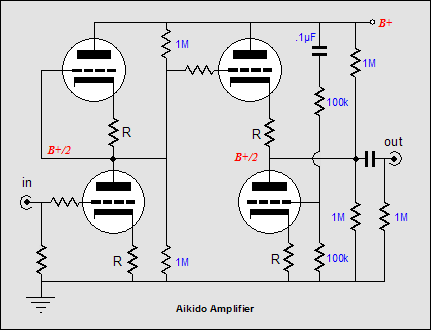

So just about any device you would want to use can be found in the library. I am currently using JLCPCB which is the company that developed the EasyEDA software.Īny schematic symbols and PCB component footprints that are created by users are available to use in your own designs. Once the design is finished, EasyEDA will generate Gerber files which can be sent to many different PCB fabrication companies.
6SN7 CATHODE FOLLOWER DOWNLOAD
This is a free download and is fairly easy to learn. This circuit was described by John Broskie on his TubeCad blog Balanced and More Balanced. The line stage is redesigned using a differential long-tail pair followed by a cross-coupled Aikido cathode follower. This new board implements the B+ supply and DC heater supply using pretty much the same design as the Glassware board. I am designing my own PCB that will fit in the same spot as the current Glassware PS-Tube and ACF boards. I mentioned in a different thread that I have decided to redesign the power supply and line stage. I'm not sure how much sense I've made, but hopefully it's been a little helpful. Sometimes it takes a few times to hit the target, but in the end each formula should confirm the result from the other.Ī lot of those parentheses have been added by myself to help me remember which equations to do first, so aren't particulalrly necessary, and probably would give a mathematician a heart attack. Plug those values into the cathode resistor formula and:įor finding the idle current for your 270 ohm resistor I took a couple of shots in the dark with the idle current formula. At 150V with an idle current of 11.5mA, I worked out the 6SN7 plate resistance is around 6875 ohm and Mu 21.8. The 6SN7 datasheet lists Mu as 20 and the Rp from 6600 to 7600 ohm depending on plate voltage. Let me know if you're interested in seeing how that's done. So to get more accurate results these two values can be calculated from the datasheet. Now the thing is, Plate Resistance (Rp) and Mu vary at different operating points. Let's concentrate on the cathode resistor formula though. Those two idle current formulas produce the same result, but I prefer dealing with the actual plate voltage whereas the original formula contains an additional element that halves the B+ value for you. That one does work, but I use a slightly modified version which is: Iq=Vp/Rp+(Rk) So the formula becomes: Rk=(-Rp)/(Mu+1)įor idle current the formula is: Iq=B+/2Rp+(Rk). It should be the plate voltage (half B+).
6SN7 CATHODE FOLLOWER FULL
When combined with a couple of calculations made from the tube datasheet itself the predicted operating parameters have so far turned out to be relatively accurate.Ĭathode Resistor = ( - Plate Resistance) / (Mu + 1) or Rk=(-Rp)/(Mu+1)īut using the full B+ volts doesn't get you the correct resistor value. I use the formulas Broskie supplies in the Aikido manual, one for calculating idle current and another for finding appropriate cathode resistor values.


 0 kommentar(er)
0 kommentar(er)
